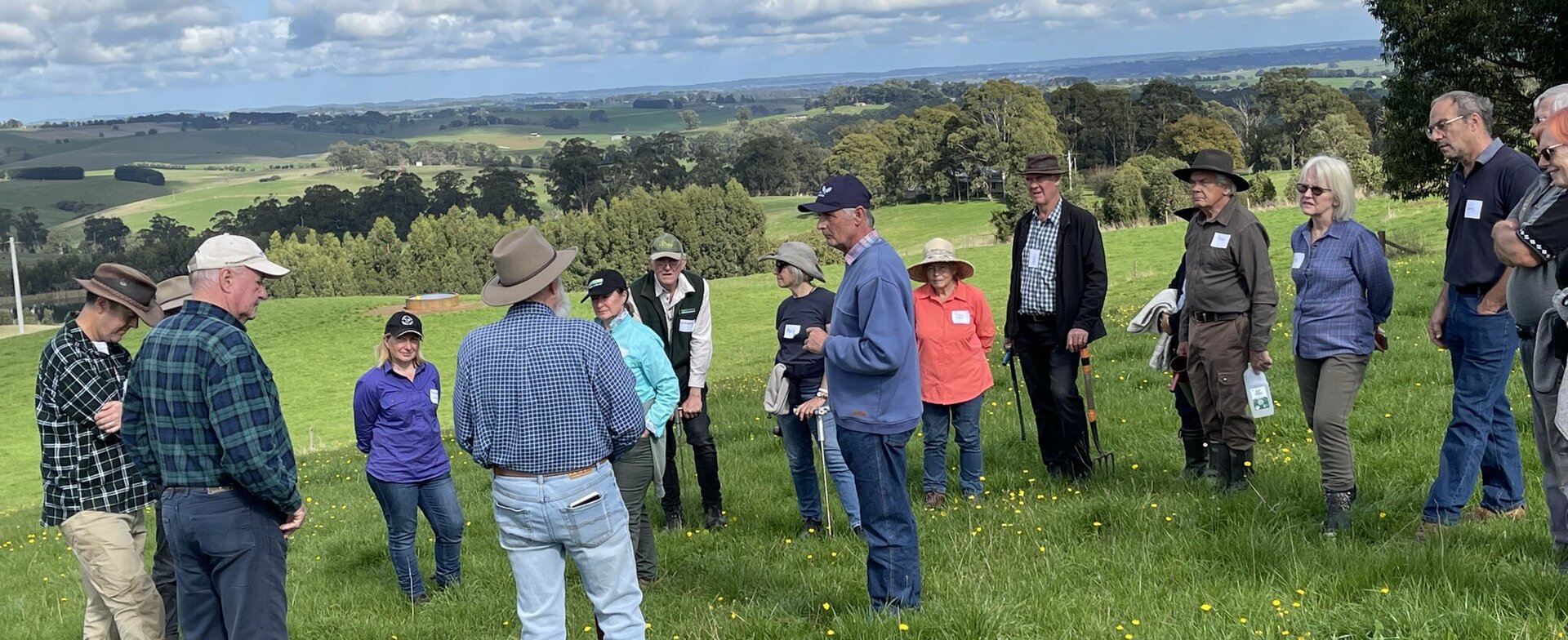Notes from the regenerative agricultural farm walk held on
Sunday April 23nd 2023
Notes for a healthy soil Program from Kevin Hughes at Soilwise Services
Building natural soil fertility depends on the soil biology being able to produce stable humus from applied nutrients, naturally occurring nutrients and available organic matter.
The soil biology is the plants digestive system, it works in co-operation with the plant roots to deliver a balanced flow of nutrients to the plant depending on the plant needs. By-passing this system with an excess of easily available water-soluble fertilisers leads to imbalances and stresses within the soil/plant system and loss of nutrients to the environment.
The soil biology consists of earthworms, dung beetles etc, and a vast array of microbes, fungi and bacteria. The most important features of the soil that effect the biology are the structure, the organic matter content and pH. The effective use of organic or non-water-soluble fertilisers (Rock phosphate, etc), animal manure and dairy effluent depend on the soil biology to stabilize and digest these materials so that nutrients they contain are fully available to the plant.
An active soil biology works co-operatively with the plant root system to produce hormones and enzymes that support healthy plant growth, it can also dissolve the bonds of tightly held soil minerals/nutrients making them available for plant growth. The soil biology makes a team effort to ‘process organic matter’ in two (at least) separate operations that should coincide.
DECOMPOSITION and HUMUS FORMATION. As the organic matter is broken down the various components released are in an ionic state (a water-soluble state like the nutrients in NPKS fertiliser) and at this stage can be leached below the rootzone or into waterways. These nutrients can be worked by appropriate organisms into pre-humic compounds that are not easily water soluble. The microbes store this material in the soil by coating it around the soil particles. It gives the soil a darker, richer colour, and is the ‘glue’ that ‘sticks’ the small fine particles together to form larger particles or aggregates; this is the friable, crumbly structure of good healthy soil. When this cycle is completed we have a constant cycle of humic compounds available for plant growth and soil structure.
The FORMATION OF STABLE HUMUS is the most important function of the soil biology, and is the first function of a healthy soil compromised when the soil becomes compacted, imbalanced or short of available, essential nutrients. By supporting the indigenous soil biology to improve the production of prehumic & humic compounds gives us the ability to manage the soil biology and harvest these compounds, improving both pasture growth & feed quality and crops yields. The soil biology goes on to store these compounds in the soil as stable humus.
Humus contains N 6%, P 1.2%, S .9% in stable Calcium carbon compounds, K is outside the humus cycle and needs to treated differently. Advantages of having Humus in your soil are:
Humus does not leech, unless the actual soil particles wash.
It absorbs and holds virtually it’s own weight in water and resists drying out, it also resists denitrifying in water-logged conditions.
Nutrients contained in humus are easily extracted by the plant roots.
Plants growing in humus rich soil are more digestible, and have a higher energy level.
Humus provides extra holding sites for soil cations(other nutrients), improving the Cation Exchange Capacity of the soil (CEC).
Increasing soil humus is an effective way of sequestering carbon dioxide.
Healthy, active biology buffers soil temperatures by 2-3 degrees.
An active healthy soil biology enables more efficient use of water-soluble nutrients (NPKS) by holding them in the plant rootzone longer as part of the biological system and by minimising their leeching from the soil solution, or their lock-up by the soil chemistry. A biologically active soil provides a natural buffer against adverse seasonal conditions. It cools or dries out more slowly supporting longer growing periods in hot or cold weather and resists water-logging, denitrifying
or drying-out excessively. The soil recovers more quickly from these stressed conditions when they occur.
Using animal manures or compost: Adequate, available soil calcium is critical to the success of applied animal manure and stimulated biology. Good quality lime or dolomite usually needs to be applied. A comprehensive soil test will indicate the nutrient and cation balances in the soil. The amount and type of lime (and other nutrients) needed can be deduced from this information. Available Calcium is essential for the soil structure, biology and chemistry, it is also a vital component of humus which increases the demand for it in a healthy biological system.
Aerating is very beneficial: Most soils are compacted to some extent at least. Opening up the soil lets in air (78%N) and moisture, this is essential for the good (aerobic) microbe & fungal colonies. We recommend a superworm/aeroway type of aeraters, they are effective, cover the ground quickly and don't need big horsepower. The yeomans and wallace type aerators are very effective and can suit some soils better. Pasture harrowing is useful.
Superworm aerator.

What humus looks like!

Same soil at the roadside.

Contract Kevin, 0427 343 866, email kchughes@bigpond.com

